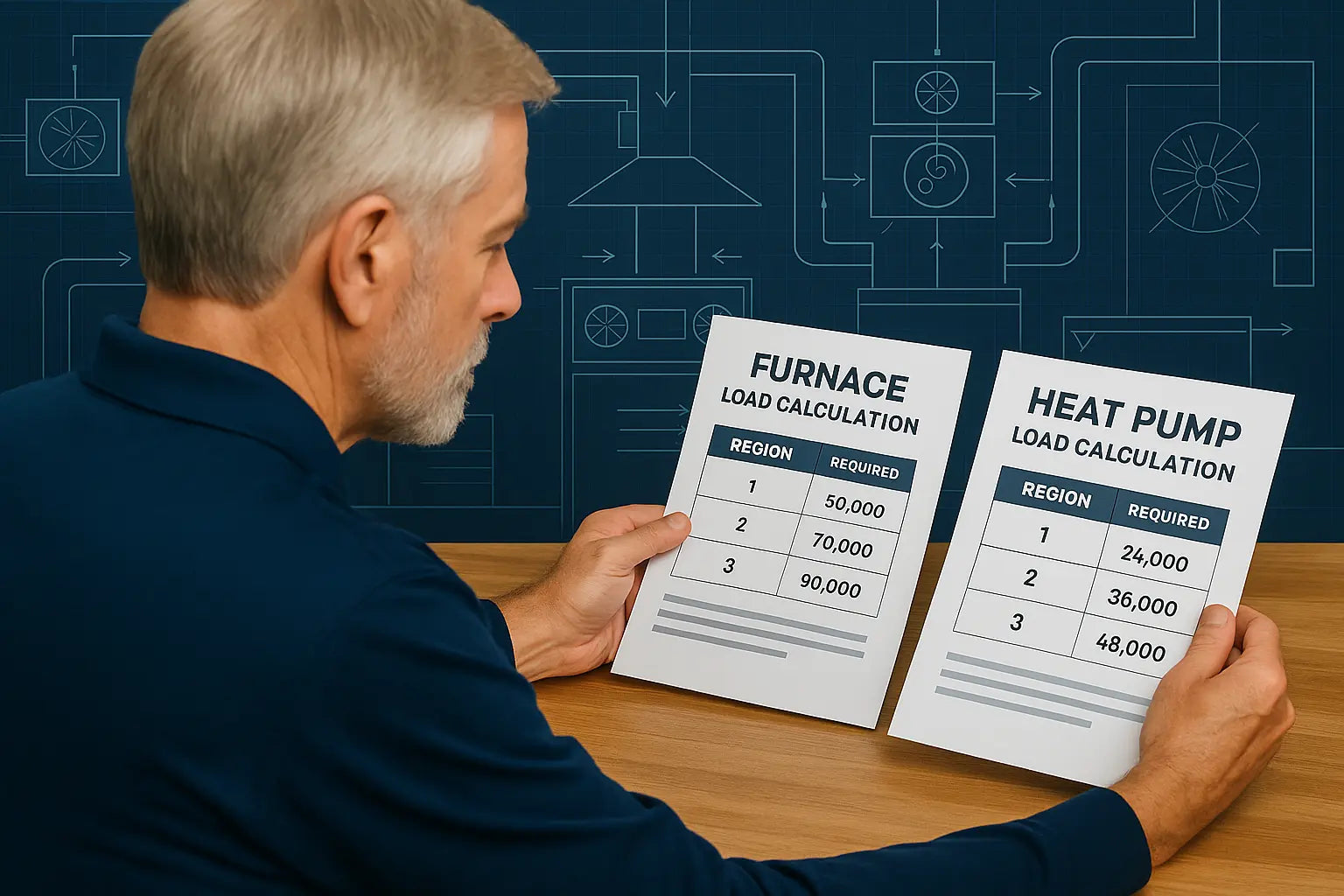Hi, I’m Alex Lane — your Home Comfort Advocate. After nearly a decade in the HVAC field and countless load calculations under my belt, I’ve seen just how important it is to size your heating system correctly. But here’s something most homeowners don’t realize: sizing a heat pump isn’t the same as sizing a furnace. They may both heat your home, but the way they deliver comfort — and the way you calculate their size — is completely different.
In this guide, we’ll break down the key differences in sizing between heat pumps and furnaces, explain why it matters, and help you make the most efficient choice for your climate and home.
Heat Pumps vs. Furnaces: Quick Comparison
|
Feature |
Heat Pump |
Furnace |
|
Fuel Source |
Electricity |
Natural Gas, Oil, or Propane |
|
Function |
Heats and cools |
Heating only |
|
Efficiency |
Very high (300%+ in mild climates) |
Varies (up to 98% AFUE) |
|
Best for |
Mild to moderate climates |
Cold climates or backup heating |
While a furnace is sized purely for heating demand, a heat pump must be sized for both heating and cooling loads — which introduces more complexity.
Understanding Heating Load vs. Cooling Load
Why It Matters
For heat pumps, the HVAC pro must balance both the heating and cooling demands of the home. Oversize it for heating, and it’ll short-cycle in the summer. Size it just for cooling, and it may need backup heat in the winter.
A furnace, on the other hand, only has to be sized for peak heating demand, usually calculated using Manual J and Manual S guidelines.
To learn more about how this sizing process works, check out our full guide: How to Size an HVAC System for Your Home.
Sizing a Furnace: Focused on Peak Heating Demand
What Goes Into It
Furnace sizing is all about matching the system’s output (in BTUs per hour) with the heat loss of the home during the coldest design temperature.
Factors include:
-
Square footage
-
Insulation levels
-
Window quality
-
Air leakage
-
Climate zone
Let’s say your home’s heating load is 60,000 BTUs. You’d look for a furnace that delivers that output at its rated AFUE efficiency.
For example, a 75,000 BTU furnace at 80% AFUE provides 60,000 BTUs of usable heat.
External Source: ENERGY STAR Furnace Efficiency Criteria
Sizing a Heat Pump: Dual Load Considerations
Heating + Cooling = Complex Balancing Act
Because a heat pump runs year-round, the sizing has to meet both cooling and heating loads. However, most units are rated for cooling capacity first.
Here’s the challenge:
-
In cold climates, the heating load can exceed the heat pump’s capacity.
-
In hot climates, you need strong cooling capacity, even if the heating load is low.
Solutions:
-
Cold Climate Heat Pumps (CCHPs) that operate efficiently below freezing
-
Dual-fuel systems that switch to a furnace when temperatures drop too low
-
Supplemental electric resistance heat to bridge the gap
External Source: Northeast Energy Efficiency Partnerships (NEEP) Cold Climate Air Source Heat Pump List
External Source: ENERGY STAR Central Air Conditioner and Heat Pump Criteria
Climate Zone Considerations
Your local climate makes a big difference:
-
Mild zones (2–4): Heat pumps may be sized more closely to cooling loads
-
Cold zones (5–7): Heating load dominates; may require supplemental heat
Not sure about your zone? Use this climate zone map from the DOE to check.
Related Article: How Climate Zones Affect Your HVAC Size Needs
Manual J: Essential for Both
Whether you’re installing a furnace or a heat pump, it all starts with a professional Manual J load calculation. This ACCA-standard method accounts for:
-
Home orientation
-
Insulation and windows
-
Local weather data
-
Occupancy and appliances
It’s the only way to get a truly accurate sizing result.
External Source: ACCA Approved Software List for Manual J Calculations
Don’t Forget Ductwork!
An oversized furnace or heat pump with undersized ducts = noisy airflow, hot/cold spots, and poor system performance.
Always make sure a Manual D calculation is performed for proper duct design.
External Source: ENERGY STAR HVAC Installation Tips
Final Take: Choose Based on Needs, Not Just Numbers
Furnaces are sized for heating only, and in some setups, can overshoot cooling if used in dual systems.
Heat pumps need to handle both heating and cooling loads, which makes accurate sizing even more important — especially in colder climates where backup may be necessary.
The best system for your home depends on: Your climate zone
-
Local energy costs
-
Year-round comfort goals
-
Whether you want a heating + cooling solution in one
Always work with a qualified HVAC contractor who will run proper Manual J and Manual S calculations — don’t rely on rules of thumb.
Want to know how your home’s ceiling height, insulation, and windows can affect those numbers? Read next: How Home Design Impacts HVAC Sizing: Ceilings, Insulation, Windows & More
And if you’re just getting started with the basics, don’t miss our full breakdown: How to Size an HVAC System for Your Home.
Alex Lane
Your Home Comfort Advocate







